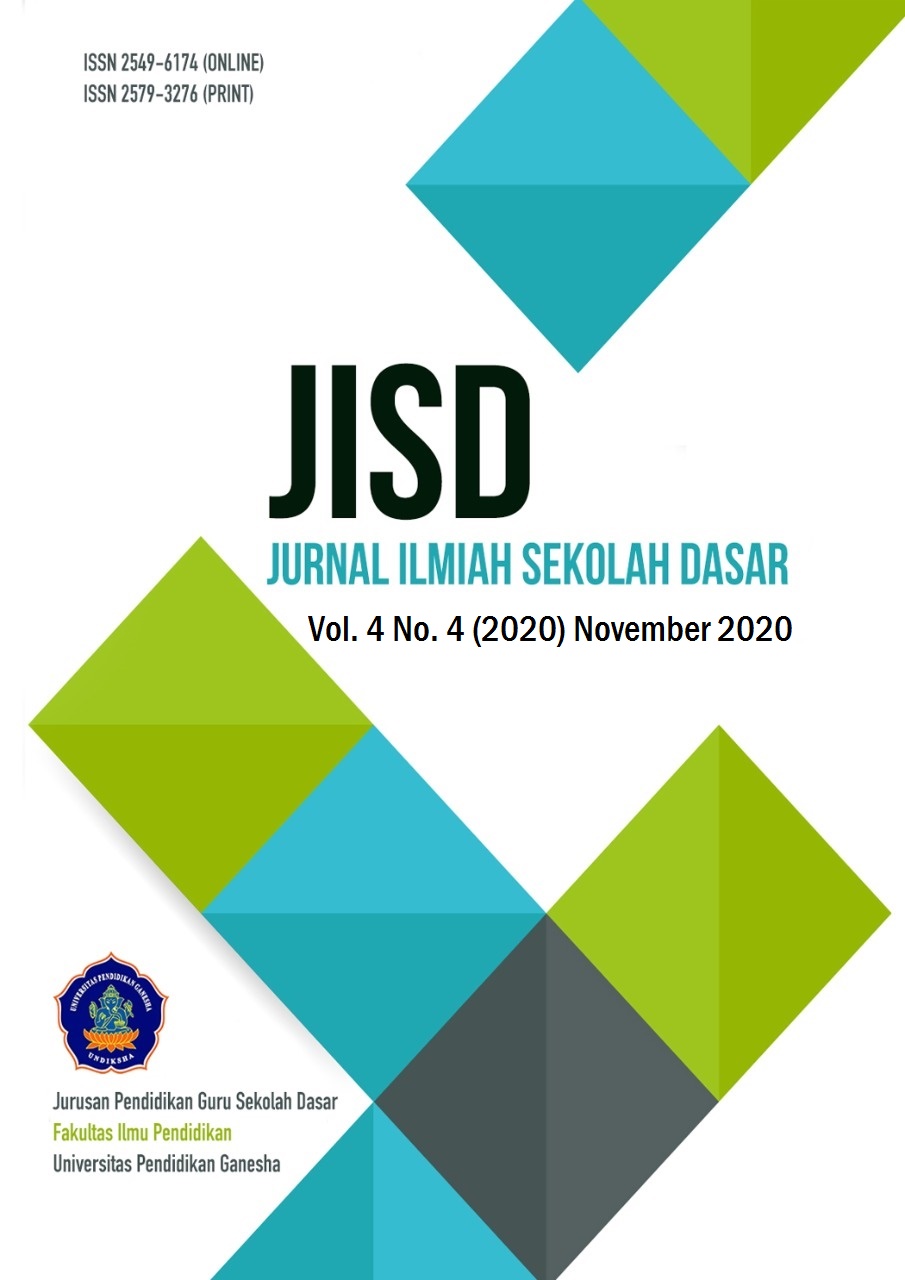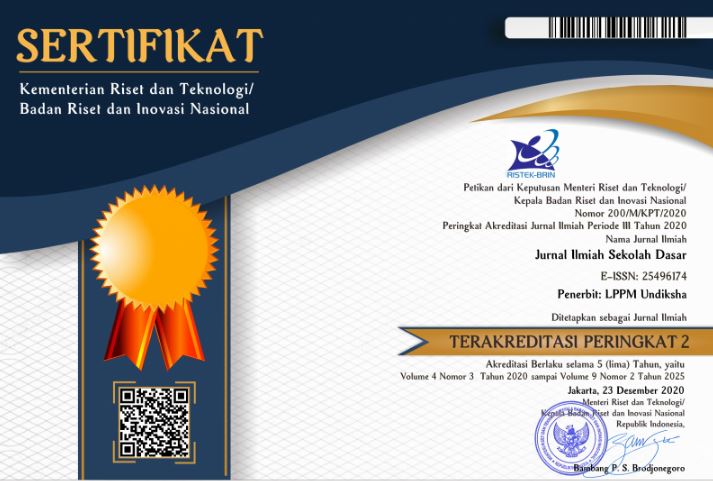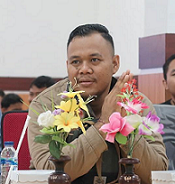School Literacy Movement Enhancing Students' Writing Skills and Creative Thinking Skills
DOI:
https://doi.org/10.23887/jisd.v4i4.29847Keywords:
school literacy movement, creative thinkingAbstract
The low of students' writing skills due to the lack of knowledge of students in writing. In addition, teachers also experience difficulties in fostering student creativity in writing. This study aims to analyze the effectiveness of the school literacy movement to improve writing skills and creative thinking skills in students. The subjects of this study were 24 students. The object of this research is the students' writing skills and creative thinking skills after the implementation of the school literacy movement. This research was conducted in several cycles. Each cycle consists of four stages, namely: Planning, Implementing Action, Observation and Evaluation of Actions, and Reflection. The data collection method used in this study is the test method. Methods of data analysis using quantitative descriptive statistical analysis methods. Based on the calculation results, the average writing skills of students in the first cycle was 67.67, increasing to 78.67 in the second cycle. While the creative thinking ability of students in the first cycle was 63.33, increasing to 75.10 in the second cycle. The improvement of students' writing skills and creative thinking abilities from cycle I to cycle II was in the medium category. It can be concluded that the school literacy movement can effectively improve students' writing skills and creative thinking skills.
References
Abbas, S. (2006). Pembelajaran Bahasa Indonesia yang Efektif di Sekolah Dasar. Jakarta: Departemen Pendidikan Nasional.
Akhadiah, S. (2003). Pembinaan Kemampuan Menulis Bahasa Indonesia. Jakarta: Erlangga.
Arikunto, S. dkk. (2008). Penelitian Tindakan Kelas. Jakarta: Bumi Aksara.
Brata, S. (2011). Ubah Takdir Lewat Baca dan Tulis Buku. Surabaya: Litera Media Center.
Dewi, N. N. K., Kristiantari, M. . R., & Ganing, N. N. (2019). Pengaruh Model Pembelajaran Picture And Picture Berbantuan Media Visual Terhadap Keterampilan Menulis Bahasa Indonesia. Journal of Education Technology, 3(4). https://doi.org/http://dx.doi.org/10.23887/jet.v3i4.22364
Dharin, A., Aziz, K. D., & Waseso, P. H. (2020). Pengembangan pembelajaran ilmu pengetahuan sosial sekolah dasar berwawasan sosial-budaya. Portal Ejournal IAIN Purwokerto, 25(1), 1–14. https://doi.org/https://doi.org/10.24090/insania.v25i1.3919
Hasani, A. (2005). Ikhwal Menulis. Serang: Universitas Sultan Ageng Tirtayasa Press.
Izati, Wahyudi, & Sugiyarti, M. (2018). Project Based Learning Berbasis Literasi untuk Meningkatkan Hasil Belajar Tematik. Jurnal Pendidikan, 3(9), 1122–1127. https://doi.org/http://dx.doi.org/10.17977/jptpp.v3i9.11508
Jayanti, Y., & Ariawan, V. A. N. (2018). Implementasi Model Experiential Learning Untuk Meningkatkan Keterampilan Menulis Karangan Narasi Siswa Sekolah Dasar. Muallimuna : Jurnal Madrasah Ibtidaiyah, 4(1). https://doi.org/10.31602/muallimuna.v4i1.1442
Joyo, A. (2018). Gerakan Literasi Dalam Pembelajaran Bahasa Indonesia Berbasis Kearifan Lokal Menuju Siswa Berkarakter. Jurnal Kajian Bahasa, Sastra Dan Pengajaran (KIBASP), 1(2). https://doi.org/https://doi.org/10.31539/kibasp.v1i2.193
Lutfia Firdausia. (2016). Peningkatan Keterampilan Menulis Puisi Menggunakan Media Musik Berlirik pada Siswa Kelas V SDN Pucung (Univesitas Negeri Yogyakarta; Vol. 5). Retrieved from https://eprints.uny.ac.id/31235/
Mansyur, U. (2016). Inovasi Pembelajaran Bahasa Indonesia. Retorika, 9(2). https://doi.org/https://doi.org/10.26858/retorika.v9i2.3806
Marliani, N. (2015). Peningkatan Kemampuan Berpikir Kreatif Matematis Siswa melalui Model Pembelajaran Missouri Mathematics Project (MMP). Formatif: Jurnal Ilmiah Pendidikan MIPA, 5(1), 14–25. https://doi.org/https://doi.org/10.30998/formatif.v5i1.166
Munandar, U. (2004). Pengembangan Kreativitas Anak Berbakat. Jakarta: PT Rineka Cipta.
Nafi’ah, A. (2017). Model-model Pembelajaran Bahasa Indonesia di SD/MI. Jakarta: Kharisma Putra Utama.
Nurgiyantoro, B. (2001). Penilaian dalam Pembelajaran Bahasa dan Sastra. Yogjakarta: BPFE-Yogyakarta.
Pertiwi, I. N., Sumarno, & Dwi, A. (2019). Pengaruh Model Make A Match Berbantu Media Kartu Bergambar terhadap Kemampuan Membaca dan Menulis. E-Journal PGSD Pendidikan Ganesha Mimbar PGSD, 7(3), 261–270. https://doi.org/http://dx.doi.org/10.23887/jjpgsd.v7i3.19412
Putri, C. A., Munzir, S., & Abidin, Z. (2019). Kemampuan Berpikir Kreatif Matematis Siswa melalui Model Pembelajaran Brain-Based Learning. Jurnal Didaktik Matematika Universitas Syiah Kuala, 6(1), 12–27. https://doi.org/10.24815/jdm.v6i1.9608
Ramandanu, F. (2019). Gerakan Literasi Sekolah (GLS) Melalui Pemanfaatan Sudut Baca Kelas Sebagai Sarana Alternatif Penumbuhan Minat Baca Siswa. Jurnal Mimbar Ilmu, 24(1). https://doi.org/http://dx.doi.org/10.23887/mi.v24i1.17405
ROHIKA, D., Marhaeni, M., & Sutama, M. (2014). Pengaruh Pembelajaran Menulis Puisi Dengan Teknik Akrostik Terhadap Hasil Belajar Menulis Puisi Dan Motivasi Berprestasi Siswa Kelas V Sd Di Gugus 6 Kecamatan Gianyar. Jurnal Pendidikan Dasar Ganesha. Retrieved from https://www.neliti.com/id/publications/123112/pengaruh-pembelajaran-menulis-puisi-dengan-teknik-akrostik-terhadap-hasil-belaja
Salma, & Mudzanatun. (2019). Analisis Gerakan Literasi Sekolah Terhadap Minat Baca Siswa Siswa Sekolah Dasar. Mimbar PGSD Undiksha, 7(2), 122–127. https://doi.org/http://dx.doi.org/10.23887/jjpgsd.v7i2.17555
Suyono, Harsiati, & Wulandari. (2017). Implementasi Gerakan Literasi Sekolah pada Pembelajaran Tematik di Sekolah Dasar Sekolah Dasar: Kajian Teori dan Praktik Pendidikan. Jurnal Sekolah Dasar Kajian Teori Dan Praktik Pendidikan, 26(2), 116–123. https://doi.org/10.17977/um009v26i22017p116
Syarifah, & Rahmawati. (2020). Penerapan Strategi BBM (Berpikir Berbicara Menulis) dalam Mengoptimalisasikan Kompetensi Menulis Cerita Fantasi. Mimbar PGSD Undiksha, 8(1), 9–20. Retrieved from https://ejournal.undiksha.ac.id/index.php/JJPGSD/article/view/24215/14875
Tarigan, H. G. (2008). Menulis sebagai suatu keterampilan berbahasa. Bandung: Angkasa.
Tompkins, J. A., & Al, E. (2003). Facilities Planning 3rd ed. New Jersey: John Wiley & Sons, Inc.
Tryanasari, Aprilia, & Cahya. (2017). Pembelajaran Literasi di SDN Rejosari 1 Kecamatan Kawedanan Kabupaten Magetan. Premiere Educandum, 7(2), 173. https://doi.org/https://doi.org/10.25273/pe.v7i2.1641
Warsihna, J. (2016). Meningkatkan Literasi Membaca Dan Menulis Dengan Teknologi Informasi Dan Komunikasi (TIK). Kwangsan, 4(2), 67–80. https://doi.org/https://doi.org/10.31800/jtp.kw.v4n2.p67--80
Warsihna, Jaka. (2016). Meningkatkan Literasi Membaca dan Menulis dengan Teknologi Informasi dan Komunikasi. Kwangsan, 4(2), 67 – 80. https://doi.org/Meningkatkan Literasi Membaca dan Menulis dengan Teknologi Informasi dan Komunikasi.
Wulansari, D. (2017). Peningkatan Kemampuan Menulis Puisi melalui Metode Pembelajaran Langsung (Direct Instruction). Jurnal Ilmiah Pendidikan Bahasa Dan Sastra Indonesia, 1, 2. Retrieved from https://jurnal.unigal.ac.id/index.php/diksatrasia/article/view/620
Zainudin. (2014). Meningkatkan Kemampuan Menulis Puisi Bagi Siswa Kelas IV SDN1 Dongko Dengan Metode Praktek. Jurnal Kreatif Tadulako Online. https://doi.org/10.1002/ajmg.1363
Downloads
Published
How to Cite
Issue
Section
License
Authors who publish with the Journal Ilmiah Sekolah Dasar agree to the following terms:
- Authors retain copyright and grant the journal the right of first publication with the work simultaneously licensed under a Creative Commons Attribution License (CC BY-SA 4.0) that allows others to share the work with an acknowledgment of the work's authorship and initial publication in this journal.
- Authors are able to enter into separate, additional contractual arrangements for the non-exclusive distribution of the journal's published version of the work (e.g., post it to an institutional repository or publish it in a book), with an acknowledgment of its initial publication in this journal.
- Authors are permitted and encouraged to post their work online (e.g., in institutional repositories or on their website) prior to and during the submission process, as it can lead to productive exchanges, as well as earlier and greater citation of published work. (See The Effect of Open Access)











